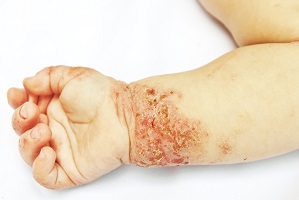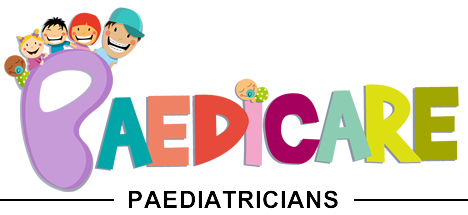
It can be extremely daunting when you first notice the inflamed dry and red patches on your child’s skin and helpless when it causes them such irritability. In his first blog post Paedicare paediatrician Dr John Gunn shares information about diagnosis and treatment of eczema in children.
What is eczema?
Eczema is also known as atopic dermatitis. Atopic means predisposition towards developing allergic/hypersensitive reactions. Dermatitis means inflammation of the skin. The main symptoms of inflammation are areas of dry, red, itchy skin. The inflammation in eczema tends to increase and decrease in severity over time. It is really common – over 10% of kids get this at some stage. It is often associated with other allergic disorders such as asthma. The exact cause remains unknown but there is probably a mixture of inherited genes that make you susceptible combined with environmental exposures that lead to this condition.
Most people are diagnosed with eczema before age five however it can also start in adulthood and is similar to childhood eczema.
-
• Infantile eczema usually starts at age three to 12 months and in the beginning can look a little like some other rashes that occur in babies that are benign. However the benign rashes will often fade away after several months while eczema will stay on and become obvious with time. Infantile eczema tends to start on the head and can have a random/widespread distribution.
• Childhood eczema usually starts in toddlers/preschool years and tends to be in the more classical areas of skin flexures: behind elbows, knees and around ankles.
How do you treat eczema?
Currently there is no ‘cure’ for eczema. However the goal of treatment is to manage symptoms as best as possible so your child will have minimal detriment from having eczema. Treatment is escalated in a stepwise fashion as follows:
-
1. Avoid triggers – sometimes taking a diary at the start can be useful. When there is an acute flare of symptoms it is often useful to look at the preceding one or two days and see if there are any unusual or recurring things that may be triggering things off.
-
- • Common things that can trigger some children are scratchy clothing; harsh soaps; bath water that is too hot; aggressive rubbing with towel after bath (pat rather than wipe). Read additional information on bathing a child who has eczema.
2. Moisturise, moisturise, moisturise – this should happen every day regardless of whether skin is bad or not. Thick ointments may be more uncomfortable but tend to last longer than thinner creams. During periods when skin is worse more frequent and/or thicker emollients (moisturisers) will be needed.
3. Use topical steroids when having flare of symptoms. When skin is getting worse/red patches this is the time to escalate treatment to include a steroid. Most of the signs/symptoms of eczema are caused by an overactive immune system. Steroids work by dampening down the action of these overactive immune cells. Your doctor will give you a prescription for this and most are used once daily until inflammation has settled down. Generally weaker steroids are used on the face/head (skin is thinner there) and stronger ones are used for body. See below for some more information on steroids.
4. Wet wraps – these are another tool to use when having acute flare-ups and can also be useful for when itch/symptoms are bad at night. Read additional information on wet wraps.
5. Occasionally when there is a flare up – the skin can become infected. One of the primary functions of skin is a physical barrier to germs. When there is bad eczema the skin can become ‘leaky’ and let bacteria in. The signs of infection are sudden worsening of one area of skin > more red/swollen/hot to touch; the skin can also become weepy/ broken/ crusted; reduced appetite; fever; lethargy. If there are signs of this then the safest thing to do is to see your treating doctor right away. If there are concerns there may be infection then antibiotics are used (as well as the other general skin treatments mentioned above). Some children require hospitalisation if it reaches this stage.
Always do step one and two. If things become worse, then work up to step three, four and five.
Additional treatments:
-
• In bigger children with prominent bouts of itch adding in an anti-histamine can often be useful (e.g. Phenergan/Claryntine). In smaller children and babies cold compresses can be useful for itch.
• Other immunosuppressant medicines e.g. Topical Calcineurin Inhibitors (Tacrolimus and Pimecrolimus) are sometimes used in difficult to treat eczema.
Most children with eczema can be successfully treated by either GP or general paediatrician. For children with severe eczema or those who are resistant to treatment – it is often a good idea to see a dermatologist (skin specialist).
Will my child grow out of eczema?
Most children with this will get better as time goes on. In general the younger you are at diagnosis, the more likely you are to grow out of it.
A recent study of 110,000 patients in 15 different countries found that in children diagnosed with eczema 20% still had persistent disease eight years after diagnosis, and only 5% after 20 years.
In children who have had eczema that has improved there will usually still be a tendency to have ’sensitive’ skin that could be lifelong.
Further reading:
-
• Lady Cilento Children’s Hospital provides a comprehensive fact sheet: Eczema
The Australasian Society of Clinical Immunology and Allergy and Royal Children’s Hospital Melbourne provide quality patient information:
DermNet NZ provides more technical information but is worth a read and has helpful photos:
If you feel you require paediatric advice for your child please contact us.
For more qualified, easy-to-understand specialist paediatric information visit Paedicare’s blog.
